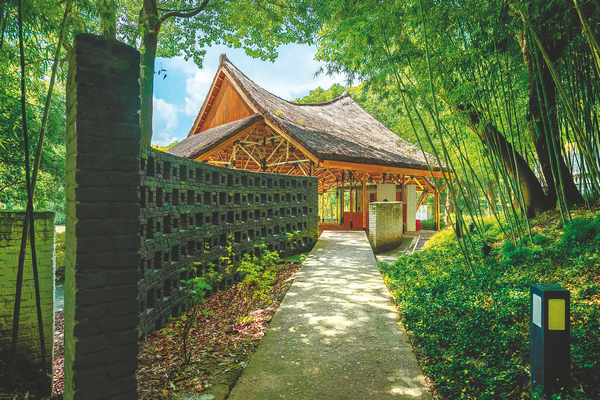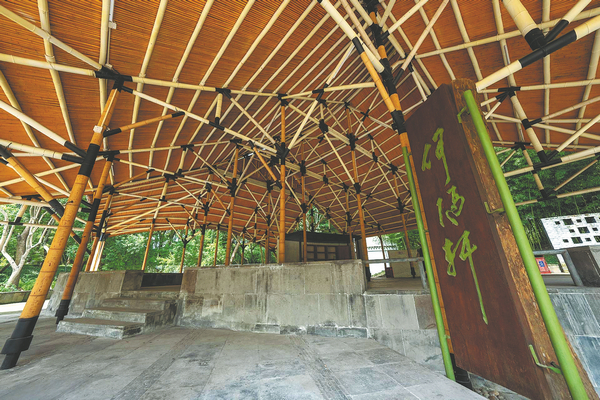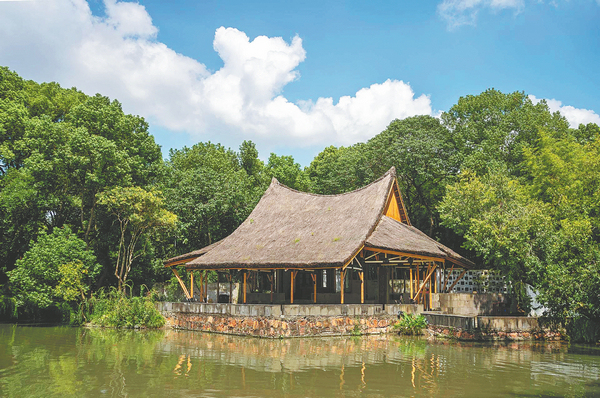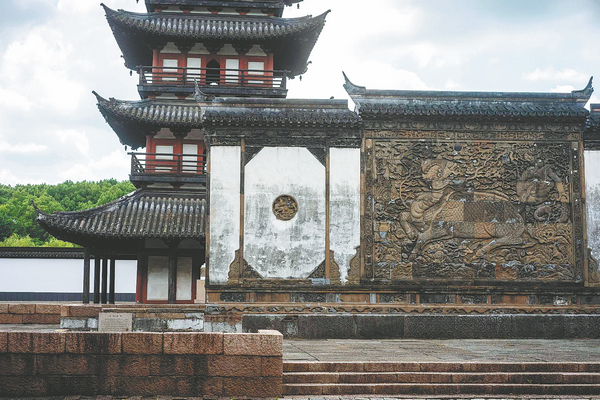Iconic teahouse is a light show to cherish

Helou Xuan is a bamboo teahouse located in Shanghai's Songjiang district.GAO ERQIANG/CHINA DAILY
Feng Jizhong's elegant bamboo pavilion reopens to public after two-year restoration, Zhang Kun reports.
The Helou Xuan, a bamboo house in Fangta Park in suburban Shanghai's Songjiang district, was named an outstanding example project for the protection of architectural heritage in Shanghai in 2023 by the municipal authorities of cultural relics protection.
The thatch-roofed pavilion supported on bamboo pillars was built in 1986.The 510-square-meter structure is 7 meters high, 16.8 meters long and 14.5 meters wide, and its high arched roof was inspired by traditional rural residences in the Yangtze River Delta.
To mark the 50th anniversary of the founding of the People's Republic of China in 1999, it was awarded a bronze prize for outstanding architecture design in Shanghai by the municipal government and was recognized as an important landmark of modern Chinese architectural design.
After undergoing a major, two-year restoration project, it reopened to the public a few months ago.
This is the first major restoration of the pavilion, an international award-winning structure designed by Feng Jizhong (1915-2009), a noted scholar of architecture.
Feng is recognized as one of the founding fathers of modern architecture, urban planning and landscape design in China. He was also a founding member of the architecture department at Shanghai's Tongji University, and the first Chinese scholar to become a Fellow of the American Institute of Architects.

Designed by Feng Jizhong it underwent a two-year restoration by Feng's student Huang Yiru.GAO ERQIANG/CHINA DAILY
Feng included the Helou Xuan tea house in a new park he was invited to design around an ancient pagoda in Songjiang district in the late 1970s.
Fangta, or the Square Pagoda, is a nine-level tower that was built as part of a Buddhist temple in the 11th century. The temple was later destroyed but the pagoda survived. Over the centuries, it underwent multiple restorations, with the latest taking place between 1974 and 1977.
A fine example of ancient Yangtze River Delta Buddhist pagodas, it has managed to preserve most of its original wood structure, and was listed in 1996 as a national treasure and is known as representative of the cultural essence of the Song Dynasty (960-1279).
In his design for the park, Feng sought to preserve the spirit of Song Dynasty culture and create an outdoor museum as a park, according to his daughter, Feng Ye.
According to Wang Shu, China's first Pritzker prize winner (architecture's Nobel), Feng Jizhong's approach also reflected the influence of modern architecture. Wang believes the design and planning of Fangta Park is second to none in China and praises the design of the park and the Helou Xuan teahouse as masterpieces that represent the essence of Chinese aesthetics and philosophy.
Fangta is around 12 hectares in size. Aside from the ancient pagoda, it is also home to a series of important cultural remains, including a brick screen wall built in 1370, which is one of the finest and best preserved tiled walls in China, and which features a monster with antlers like a deer, a tail like a lion, scales of a fish and hoofs of an ox.
The Temple of the Queen of Heaven, the largest Mazu Temple in Shanghai, was also relocated to the park from Suzhou Creek.

Helou Xuan is a bamboo teahouse located in Shanghai's Songjiang district. Designed by Feng Jizhong it underwent a two-year restoration by Feng's student Huang Yiru. The legendary building recently reopened to the public. GAO ERQIANG/CHINA DAILY
Feng Jizhong took a minimalist approach to his design and connected these important sites via gateways, paths, squares and walls, allowing the elements to remain independent. Their coexistence creates a spatial balance that combines traditional Chinese garden art with modern architecture, Wang says.
The teahouse is located in a secluded corner of the park. Visitors have to walk along two brick arcades before reaching the front of the pavilion, which is a striking sight with its thickly thatched grass roof supported on slender bamboo poles. A natural material that has been used in Chinese architecture for thousands of years, bamboo is resilient and enduring if properly protected, Wang says.
Feng Jizhong painted all the nodes, where the bamboo connects, black, and had steel bases designed for each of the pillars, like shoes for feet, to protect the natural material from excessive humidity. Although the thatch has been changed every year, the main bamboo structure has survived over 30 years.
He envisaged the bamboo aging and eventually decaying and had his disciple Huang Yiru spend six months making an accurate model, so that the pavilion could be rebuilt when necessary.

The legendary building recently reopened to the public. GAO ERQIANG/CHINA DAILY
Now the deputy director of the college of architecture and urban planning at Tongji University, Huang headed the restoration project himself.
"We had three-dimensional scanning done before dismantling the structure,"Huang says, "so that the imagery can be used in the future when it has to be rebuilt again".
To remain as faithful to the original design as possible, Huang managed to find 4- to 6-year-old bamboo from Anji in Zhejiang province, and sourced the thatch in Lianyungang in Jiangsu province.
He also added a new wall across the river to the south of the pavilion and says that Feng Jizhong had plans for the design of the teahouse that were not completed due to a lack of funds. "By adding this wall, the project extends to the other side of the river, and the landscape becomes complete," Huang says."The Helou Xuan was Feng Jizhong's last project, and he considered it his best."
"Lots of elderly people spend the whole day here when the weather is fine," says Xiao He, who works in the park administration.
From inside the pavilion, people can see rays of sunlight in the morning, and shadow arches created by the wall. Anyone who enjoys a cup of tea, or a game of Chinese chess will enjoy spending time at the pavilion watching the changing light.
Contact the writer at zhangkun@chinadaily.com.cn

